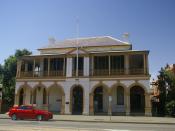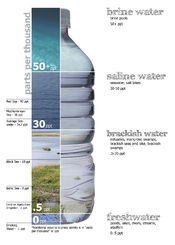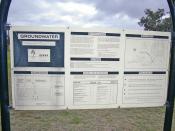Dry-land salinity is a huge environmental problem. It is important to distinguish between Dry land salinity and irrigated land salinity. In this case the affected area is due to rain and not farmers irrigating crops. Dry land salinity is the gradual loss of land due to rising salt. This salt is raised to the earth's surface by rising groundwater. We have known about this problem since 1924 but have only tried to seriously understand it since the 70's.
There are vast amounts of salt in Australia most of which is located underground. It has been built up over thousands of years originating from rock minerals or from sea salt dropped by wind or rain. Australia's native vegetation is adapted to the salty conditions. They have deep roots and high water use that kept the ground water levels low and the system in balance. But when European farming methods were introduced the ground water began to rise.
This is because the crops used had shallow roots and did not use up much water. This excess water would leak down to the water table and raise ground water levels. The ground water would then dissolve any salt and once at the surface the water would evaporate and deposit the salt there. The volumes of water and salt are vast.
Salinity can also do damage downstream. Aquatic ecosystems, bio diversity and urban infrastructure are being damaged by increasingly saline groundwater. For example the NSW town of Wagga Wagga needs to find half a million dollars a year to repair the corrosion and degradation of roads, footpaths, parks, sewage pipes and housing by saline seepage.
Dr. John Williams, Deputy chief of the CSIRO land and water division said: "What has changed is that we have recognised the seriousness of the problem, and the need for radical land use change"æWe must face radical land use change, because we don't have farming systems that can control salinity and at the same time generate sufficient income for social and community well-being in the rural sector." Many of our agricultural systems are unsustainable. They leak water but also nutrients which are simply drained away by the excess water. We don't yet know how to design a system that would capture water and nutrients in the way that the Australian ecosystems does. A possibility could be the extensive replanting of native vegetation. Imported European systems, however, cannot emulate the native vegetation.
2.5 million hectares are affected by salinity. This could soon turn into 15 million and much of the area affected is some of our most productive agricultural land. In western Australia the western wheat belt is losing an area equal to one football oval an hour. South Australia's water supply is under threat. Testing at a site just south of where our water is drawn from has revealed that over the next 20 to 30 years, at current levels, salinity will increase to the stage where it will be outside World Health Organization recommended drinking levels.
Scientists are now calling for industrial strength land care. This will have enormous implications. The structure of rural communities will change and the economics of regional Australia will have to shift rapidly. What is needed is quick response, more research and a government who will make potentially unpopular decisions. The replanting of native trees that are able to control the salt to more desirable levels is needed across most of the Australian landscape, including fifty to seventy percent of catchment areas to achieve significant reductions in salinity. Groundwater pumping is another alternative solution. This is when water is pumped out of the groundwater store and is released into evaporative disposal basins. This is an expensive solution and may prove commercially unviable. Other proposed solutions would be a pipeline to the sea to drain saline water to the sea. This would be a long-term fix but is estimated to cost over half a billion dollars.
In conclusion there are four areas that are affected by Dry land salinity: ÃÂ÷ Declining water quality in rivers.
ÃÂ÷ Loss of productive land and a drop in agricultural production.
ÃÂ÷ Damage to built infrastructure including buildings and roads.
ÃÂ÷ Degradation of the environment, including loss of bio-diversity.
Finally Dr. Tom Hatton of the CSIRO has put the problem in perspective by saying: "I would say without question this is the largest environmental crisis we face, and if people don't believe me now, they soon will." Bibliography Murphy, Justin http://www.abc.net.au/science/slab/salinity/ [accessed online 20 April 2001] Geo processors http://www.geo-processors.com.au/salinity.html [accessed online 20 April 2001] Environmental news network http://www.enn.com/enn-news-archive/1999/06/062599/salt_3990.asp [accessed online 20 April 2001]





